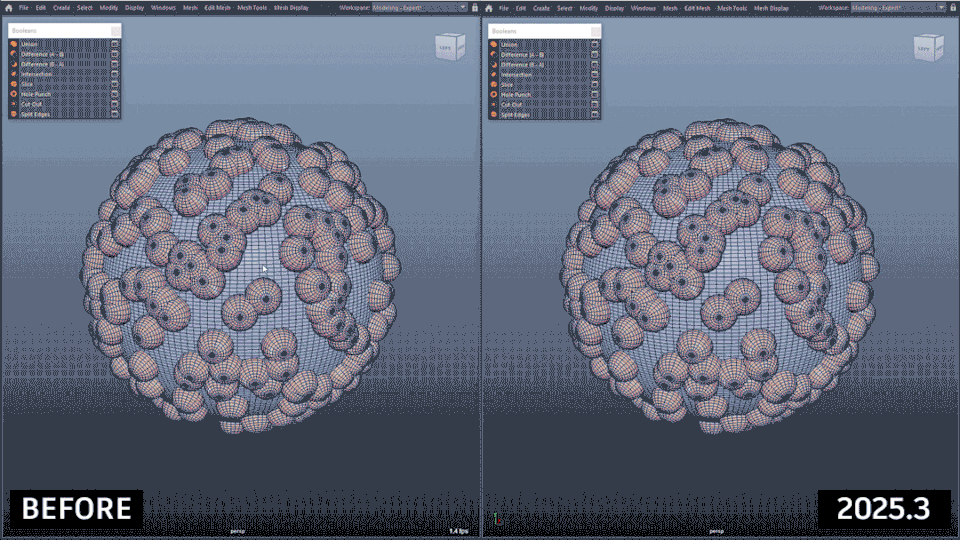Autodesk releases Maya 2025.3

Maya 2025.3 introduces support for OpenPBR, the Autodesk co-developed open material standard, used in this demo scene created by look dev artist Nikie Monteleone.
Autodesk has posted the online documentation for the new features in Maya 2025.3, the latest version of its 3D modeling and animation software.
The update reworks Maya’s Boolean algorithm, making Boolean modeling operations more reliable on complex models and those with problem geometry.
It is also now possible to work with OpenPBR materials in Maya, thanks to the support for the new open material standard in both the LookdevX toolset and the Arnold renderer.
Simulation toolset Bifrost for Maya gets a new option to ‘wedge’ simulations in the cloud.
At the time of writing, Autodesk hasn’t announced the release on its product timeline, but according to the online documentation, it is now available to subscribers.

3D modeling: new, more reliable Boolean algorithm
Key changes in Maya itself include an update to Boolean modeling.
The software’s Boolean algorithm has now been updated to match the one in 3ds Max, also improving the predictability and reliability of Boolean operations.
According to Autodesk, the improvement is quite significant: in its internal tests, the old Boolean system would fail in 6% of cases, reduced to 0% with the new algorithm.
The change should be most noticeable on problem geometry, such as meshes with coincident vertices or coplanar faces, and on complex Booleans with multiple source meshes.
Animation: workflow updates to the Graph Editor
Animators get workflow updates to the Graph Editor.
Change include a new Auto-resize keys on zoom option, which resizes keys when zooming out, and new settings to control the appearance of tangent handles in the Graph view.

LookdevX: support for the new OpenPBR material standard
Outside the core application, there are updates to the key plugins included with Maya, including LookdevX, the new look dev toolset introduced in Maya 2024.
The big change in LookdevX for Maya 1.6.0 is support for OpenPBR, the new open material standard developed by Autodesk and Adobe.
A unified successor to the Autodesk Standard Surface and Adobe Standard Material, it is intended to increase interoperability between of material between CG applications.
Other changes include the option to save compounds – groups of nodes within the shading graph – for reuse in future projects, or to share with collaborators.
There are also three new gradient types, Radial, Circular and Box, in the Ramp node.
Arnold for Maya 5.4.5: a wide-ranging update
OpenPBR is also now supported in Maya’s integration for the Arnold renderer.
Arnold for Maya 5.4.5 introduces a new OpenPBR Surface shader, and tools to convert Arnold’s aiStandardSurface shaders to OpenPBR Surface.
The release also updates Arnold’s own Ramp shaders, which get new 3D ramp modes, and the option to add procedural noise to the ramps generated.
The Tonemap imager gets a self-descriptive heatmap mode, which generates heatmap-style effects in renders.
Volume rendering workflow has also been improved, with volumes now displayed in the viewport, and two new parameters for controlling light scattering.
For denoising renders, the OIDN (OpenImageDenoise) denoiser is now supported on AMD as well NVIDIA GPUs on Windows, and on Apple Silicon processors on macOS.
Under the hood, GPU rendering performance has been improved, particularly on scenes containing large numbers of lights or instances.
There are also a lot of smaller feature and workflow improvements, so check out the release notes for a detailed list.

Bifrost for Maya: Flow Wedging lets you run variant simulations in the cloud
Bifrost for Maya, Maya’s multiphysics plugin, gets an interesting update, with Bifrost for Maya 2.11 introducing an experimental modular rigging framework.
Users also get the option to ‘wedge’ simulations, generating variant simulations with a range of parameter values, in the cloud.
We wrote about Bifrost for Maya 2.11 when it was released, so check out our original story for the full details.
USD for Maya: control USD cameras with Maya’s native camera controls
Maya’s USD integration gets a more workflow-focused update, with USD for Maya 0.30 making it possible to use Maya’s native camera controls to manipulate USD cameras.
It is also now possible to reload references, payloads and nested references for prims in the Outliner, and to set custom text colors for prims.
Updated 17 October: Maya Creative 2025.3 also available
Autodesk has also released Maya Creative 2025.3, the new version of the cut-down edition of Maya aimed at smaller studios, and available on a pay-as-you-go basis.
It has the same key new features as Maya 2025.3 itself, although Maya Creative is not able to author new Bifrost graphs, only to run existing ones.
Price and system requirements
Maya is available for Windows 10+, RHEL and Rocky Linux 8.7/9/3, and macOS 12.0+.
The software is rental-only. Subscriptions cost $235/month or $1,875/year.
In many countries, artists earning under $100,000/year and working on projects valued at under $100,000/year, qualify for Maya Indie subscriptions, priced at $305/year.
Read an overview of the new features in Maya 2025 on Autodesk’s website
Read a full list of new features in Maya 2025.3 in the online documentation
Have your say on this story by following CG Channel on Facebook, Instagram and X (formerly Twitter). As well as being able to comment on stories, followers of our social media accounts can see videos we don’t post on the site itself, including making-ofs for the latest VFX movies, animations, games cinematics and motion graphics projects.
